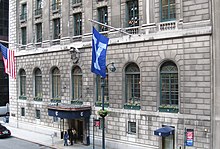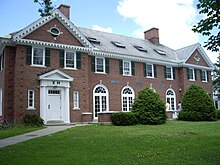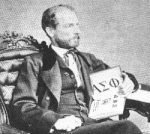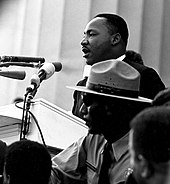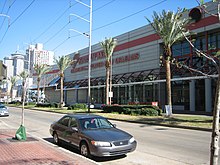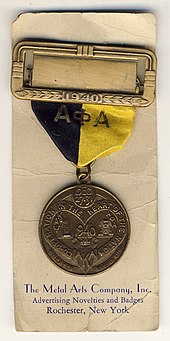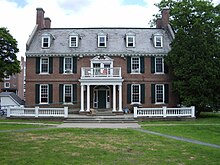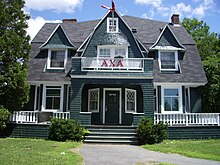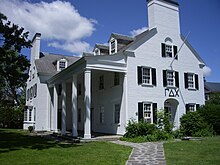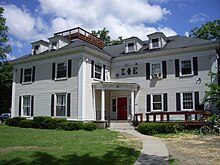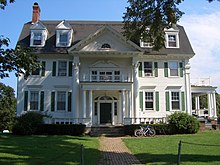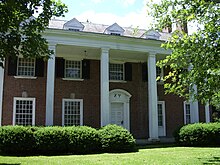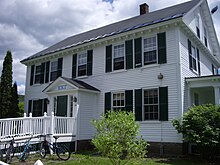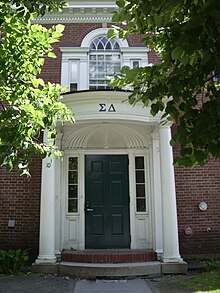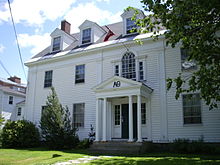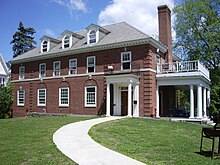Dartmouth College is host to many Greek organizations and a significant percentage of the undergraduate student body is active in Greek life. In 2005, the school stated that 1,785 students were members of a fraternity, sorority, or coeducational Greek house, comprising about 43 percent of all students, or about 60 percent of the eligible student body.[1] Greek organizations at Dartmouth provide both social and residential opportunities for students, and are the only single-sex residential option on campus. Greek organizations at Dartmouth do not provide dining options, as regular meals service has been banned in Greek houses since 1909.
Social fraternities at Dartmouth College grew out of a tradition of student literary societies that began in the late eighteenth and early nineteenth centuries. The first social fraternities were founded in 1842 and rapidly expanded to include the active participation of over half of the student body. Fraternities at Dartmouth built dedicated residence and meeting halls in the early 1900s and in the 1920s, and then struggled to survive the lean years of the 1930s. Dartmouth College was among the first institutions of higher education todesegregate fraternity houses in the 1950s, and was involved in the movement to create coeducational Greek houses in the 1970s. Sororities were introduced to campus in 1977. In the early 2000s, campus-wide debate focused on whether or not the Greek system at Dartmouth would become “substantially coeducational”[citation needed], but most houses retain single-sex membership policies.[citation needed]
Currently, Dartmouth College extends official recognition to sixteen all-male fraternities, nine all-female sororities, and three coeducational fraternities. The Greek houses are largely governed through three independent councils, the Interfraternity Council, the Panhellenic Council, and the Coed Council. Dartmouth College has two cultural interest fraternities, and two cultural interest sororities, which do not participate in the major governing councils, but are member organizations of national associations. A chapter of the Phi Beta Kappa honor society is active, but there are no professional fraternities with active chapters at Dartmouth College.

History[edit]
Dartmouth Hall, circa 1834.
Social fraternities at Dartmouth College grew out of a tradition of student literary societies that began in the late eighteenth and early nineteenth centuries. The first such society at Dartmouth, the Social Friends, was formed in 1783. A rival organization, called the United Fraternity, was founded in 1786. A chapter of Phi Beta Kappa was established at Dartmouth in 1787, and counted among its members Daniel Webster, class of 1801.[2] These organizations were, in large part, the only social life available to students at the College. The organizations hosted debates on a variety of topics not encountered in the curriculum of the day, and amassed largelibraries of titles not found in the official College library. Both the Social Friends and the United Fraternity created libraries in Dartmouth Hall, and met in a room called Society Hall inside Dartmouth Hall. In 1815, the College decided to intervene in the hotly contestedrecruitment battle between the Social Friends and the United Fraternity by restricting each society to recruit only from separate halves of the new student class. In 1825, the College began simply assigning new students to one society or the other. Interest in the literary societies declined in the 1830s and 1840s. The College library and instructional curriculum had expanded to include much of what the literary societies had supported, and new Greek letter societies began to appear on campus.[3]
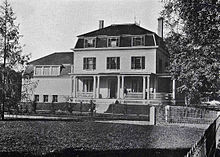
The second physical plant of Kappa Kappa Kappa, located at 22 North College Street and occupied by the fraternity from 1894 to 1924. The fraternity added the “goat room” (meeting room) at the rear.[4]
In 1841, two factions of the United Fraternity split off from the literary society. One of the new societies called itself Omega Phi and on May 10, 1842, obtained a charter as the Zeta chapter of Psi Upsilon. The other faction to split from the United Fraternity organized itself on July 13, 1842, as Kappa Kappa Kappa, a local fraternity. More Greek organizations were founded, and by 1855, 64% of students, mostly upperclassmen, were members of the Greek letter societies on campus.[3] Initially, the original Greek letter societies would not extend invitations of membership to first year students. Two separate Greek letter organizations were created exclusively for freshmen: Kappa Sigma Epsilon and Delta Kappa. These societies would dissolve in 1883, when the fraternities of the upper classes began to pledgefreshmen.[5] A chapter of Phi Beta Kappa survived at Dartmouth, but by the 1830s had established its role as a strictly literary society by dropping requirements of secrecy for membership and activities.[6] The new, social Greek organizations distinguished themselves from Phi Beta Kappa and the previous literary societies in several ways. The new fraternities were self-selective and exclusive. Each organization developed its own secret rituals and procedures. Most of the societies began to invest in creating their own meeting halls, either upstairs rooms in buildings on Main Street, or free-standing structures near campus. There were 11 active Greek organizations at Dartmouth College in 1900.[a]
Expansion of the fraternity system[edit]

Dartmouth Beta House circa 1920, would later become home to the Tucker Foundation.
The fortunes of the fraternity system at Dartmouth followed a boom and bust pattern in the early twentieth century. Several organizations purchased frame houses or built their own between 1899 and 1907, including Beta Theta Pi, Kappa Kappa Kappa, Phi Delta Alpha, andPsi Upsilon. The economic expansion of the 1920s created a boom in the fortunes of the fraternities, allowing many to build new brick residences near campus, including Zeta Psi, Kappa Kappa Kappa, Phi Sigma Kappa, Sigma Nu, Sigma Alpha Epsilon, Chi Phi, Theta Delta Chi, Phi Gamma Delta, Sigma Chi, Gamma Delta Chi, and Delta Tau Delta. It was during this period that Webster Avenue developed as “fraternity row”.[3] The new residences were built without significant dining facilities, as the Trustees of the College had banned fraternities from serving regular meals in their chapter houses and had limited the number of resident brothers by the fall semester of 1909.[7] College administrators also challenged the fraternities to become more engaged in College life and less focused on their fraternity life during this time. College President Ernest Martin Hopkins personally decided to abolish freshman rush in 1924.[5]
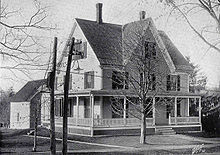
Delta Tau Delta, shown here circa 1915, would in 1960 become today’s Bones Gate fraternity.
As did the nation, fraternities at Dartmouth went through difficult times during the Great Depression. The decade of the 1930s saw almost no building projects at all in the fraternity system, and many houses could no longer afford regular maintenance. One of the great tragedies at Dartmouth College occurred on a winter night in 1934, when nine members of Theta Chi died from carbon monoxidepoisoning after a metal chimney on a dilapidated coal furnace in the basement of the chapter house broke in the night.[8] In 1935, Dartmouth historian and professor Leon Burr Richardson asserted in a survey that, in light of the national suffering, the fraternity chapters should ask themselves if they had “any excuse for existence.”[5] Four fraternities dissolved during the Great Depression (Alpha Sigma Phi,Alpha Tau Omega, Lambda Chi Alpha, and Sigma Alpha Mu), and two (Phi Kappa Sigma and Alpha Chi Rho) merged to pool scarce resources in order to survive. All of the surviving fraternities closed for the duration of World War II, as the campus was largely (although not exclusively) used to educate, train, and house Navy sailors and Marines in the V-12 Navy College Training Program.[9][10]
The fraternities of Dartmouth College were directly involved in the African-American Civil Rights Movement of the 1950s. In 1952, the Dartmouth chapter of Theta Chi was derecognized by its national over a dispute regarding minority membership. The Dartmouth chapter reorganized as a local fraternity named Alpha Theta. A campus-wide referendum held in 1954 on the issue of desegregation of fraternities resulted in a majority in favor of requiring fraternities on campus to eliminate racially discriminatory membership policies by the year 1960, and to secede from national groups that retained such policies in their charters. This became a binding obligation imposed on the fraternities by the college administration, and several fraternities at Dartmouth dissociated from their national organizations, including the chapters of Phi Sigma Kappa (1956),[11]Delta Tau Delta (1960), Phi Delta Theta (1960), Sigma Chi (1960), and Sigma Nu (1963).
National social changes also affected Greek societies at Dartmouth in the 1960s and 1970s. Many began to question the value of belonging to a national fraternal organization. The Dartmouth chapters of Chi Alpha Rho, Chi Phi, Delta Upsilon, Phi Gamma Delta, Phi Kappa Psi, and Sigma Phi Epsilon all disaffiliated from their national fraternities in the 1960s. As political activism increased, fraternities were increasingly seen as anachronistic, and in 1967, the faculty voted 67-16 to adopt a proposal to abolish fraternities at Dartmouth. The proposal was rejected by the Board of Trustees.[12]
Coeducation to the present[edit]
Coeducation would dramatically change all social life at Dartmouth College, including the fraternity system. The College first began admitting women as full-time students in 1972. By the fall of 1973, five local fraternities (Alpha Theta, Foley House, The Tabard, Phi Tau, and Phi Sigma Psi) had all decided to adopt a coeducational membership policy and admit women as full members. The first sorority on campus, Sigma Kappa, was founded in 1977. Many alumni expressed strong concerns that the need for housing for new sororities would inevitably lead to financial pressure and the possible dissolution of existing fraternities at the College. In response, the Trustees imposed a moratorium limiting the campus to no more than six recognized sororities.[13] Converting from an all-male to a coeducational membership policy was not enough to save at least one Greek organization on campus. In 1981, the Harold Parmington Foundation reorganized itself as a new coeducational fraternity Delta Psi Delta, but the organization never attracted many new members and was finally forced to dissolve in the spring of 1991. In addition, Foley House disassociated from the Greek system in Fall 1984, transitioning into an affinity house as part of the College’s residential living programs. It moved off Webster Avenue to a new location on West Street (where it is still in operation as of the 2013-14 academic year).
During the 1980s and 1990s, College administrators introduced new initiatives to hold the Greek organizations on campus more accountable for their actions and to offer more social alternatives to the predominantly single-sex Greek system. In 1982, the administration announced that Greek organizations would have to comply with a set of “minimum standards”, enforced through annual reviews, in order to remain in good standing with the College. These standards included not only health and safety regulations regarding the conditions of the Greek houses, but requirements for Greek-sponsored activities deemed beneficial to the College community at large.[12] The College introduced Undergraduate Societies to campus in 1993, as a residential and social alternative to Greek organizations. Similar to the Greek houses in many respects, Undergraduate Societies were required to have open, coeducational membership policies. Panarchy voted to change its status to an undergraduate society and was joined the following year by a newly formed society, called Amarna.[14] In the fall of 1993, Student Assembly President Andrew Beebe, class of 1993, argued in favor of the coeducation of the entire Greek system in his remarks at fall Convocation.[15] During that same academic term, College President James O. Freedman predicted that the Greek system at Dartmouth would be coeducational within 10 years.[13]
In 1999, the college administration announced a “Residential and Social Life Initiative” to improve campus life. Speculation that all single-sex fraternities and sororities would be required to adopt coeducational membership policies led to intense campus debate. In a survey conducted by The Dartmouth newspaper, 49% of the student body responded, and 83% of those respondents were in favor of retaining a single-sex Greek system at Dartmouth.[16] In a December, 2006 interview, College President Jim Wright admitted that it had been “a serious mistake” to announce the Student Life Initiative in the manner in which it was presented to the campus, but expressed that in his opinion, “the Greek system at Dartmouth now is stronger than it’s ever been.”[17]
Fraternities[edit]
The single-sex male-only fraternities at Dartmouth College are largely organized and represented to the College through the Interfraternity Council (IFC). The Interfraternity Council is a student-led governance organization that assists the member Greek organizations with finances, public relations, programming, judicial administration, recruitment, and academic achievement. Alpha Phi Alpha is not a member of the IFC, but is a member of the National Pan-Hellenic Council. Lambda Upsilon Lambda is also not a member of the IFC, but is a member of the National Association of Latino Fraternal Organizations.[18]
Alpha Delta (ΑΔ)[edit]
Alpha Delta (“AD”) was initially founded by members of the Gamma Sigma Society. In 1847, the society became the Dartmouth chapter ofAlpha Delta Phi, a national fraternity.[12] The house dissociated from its parent corporation in 1969 and renamed itself The Alpha Delta Fraternity. Alpha Delta is well known for being part of the inspiration behind the movie National Lampoon’s Animal House. The screenplay, co-written by Chris Miller, class of 1963, was inspired by a pair of short stories Miller wrote in National Lampoon in 1974 and 1975 (“The Night of the Seven Fires” and “Pinto’s First Lay”) about his experiences as a member of Alpha Delta. In November 2006, Miller published a 336 page memoir of his experiences in the fraternity under the title The Real Animal House: The Awesomely Depraved Saga of the Fraternity That Inspired the Movie.[19] Alpha Delta was derecognized by Dartmouth College on April 13, 2015.[20]
Alpha Phi Alpha (ΑΦΑ)[edit]
The Theta Zeta chapter of Alpha Phi Alpha was founded as the first historically African-American fraternity at Dartmouth College in 1972. The first members of the fraternity traveled to Boston, Massachusetts on the weekends of the 1971 spring academic term to attend pledge events at the Sigma chapter. The Dartmouth chapter was chartered as the 381st chapter of Alpha Phi Alpha on May 12, 1972. Early chapter meetings on campus were held in both the Choates dormitories andCutter-Shabazz Hall. The fraternity secured their own house in 1982, a duplex structure that, since renovated, today houses the Delta Delta Delta sorority. Facing smaller membership, the fraternity decided to relocate to a smaller house near the western end of Webster Avenue in the late 1980s, and in 1992, the fraternity again relocated to College-owned apartment housing. The Dartmouth chapter of Alpha Phi Alpha sponsors an annual step performance known as the Green Key StepShow.[21] Notable alumni of the chapter include National Football League all-star Reggie Williams, class of 1976,[22] and current Executive Vice President of Baseball Operations in Major League Baseball,Jimmie Lee Solomon, class of 1978.[23][24]
Alpha Chi Alpha (ΑΧΑ)[edit]
Alpha Chi Alpha (“Alpha Chi”) was founded in 1956 as the Phi Nu chapter of Alpha Chi Rho, a national fraternal organization. A previous Phi Nu chapter of Alpha Chi Rho at Dartmouth had merged with the Kappa chapter of Phi Kappa Sigma in 1935 to become Gamma Delta Chi, a local fraternity still in existence at Dartmouth. The second Phi Nu chapter of Alpha Chi Rho is unrelated to the first chapter. The men of Alpha Chi Rho again broke away from the national group in 1963 and became a local fraternity named Alpha Chi Alpha.[25] The Dartmouth chapter objected to a clause in the national fraternity organization’s constitution that required all Alpha Chi Rho brothers to “accept Jesus as their lord and savior.” The land and house used by the Alpha Chi Alpha fraternity are owned by the college. Dartmouth invested $1.3 Million in renovations completed in the fall of 2004, which included the razing of the “Barn” structure that was used as social space by the brothers of Alpha Chi Alpha to make way for a new expanded basement and main floor area.[26] Renovations on the Alpha Chi Alpha physical plant were completed in 2005.[27]
Dartmouth Beta (ΒΑΩ)[edit]

Dartmouth Beta House, 2009
Dartmouth Beta (“Beta”) was founded in 1858 as a local fraternity at Dartmouth’s Chandler Scientific School named Sigma Delta Pi. Sigma Delta Pi was the second Chandler fraternity and the seventh fraternity founded at the College. The fraternity changed its name to Vitruvian (a tribute to the Roman architect Vitruvius) in 1871 and later established two short-lived chapters at other schools. In 1889, the local brotherhood decided to join a national fraternity and the organization soon became the Alpha Omega chapter of Beta Theta Pi. It built a house (now South Fairbanks Hall) designed by Beta graduate, Charles A. Rich of Lamb & Rich in 1904, and it built its second house, on Webster Avenue, in 1933. Notable alumni of the organization include but not limited to: Former U.S. Representative from New HampshireFrank G. Clarke, Author Norman Maclean, Former Governor of New Hampshire Walter R. Peterson ’47, Businessman Alan Reich ’52, Former Dartmouth President David T. McLaughlin ’54, Owner of the Cincinnati Bengals Mike Brown ’57,[28] Founder of the Big East Conference Dave Gavitt ’59,[29] Former Athletic Director of Syracuse University Jake Crouthamel ’60,[30] Member of College Football Hall of Fame and Chief Executive Officer of the Hanover Company Murry Bowden ’71, Professional Poker Player Chip Reese ’73,[31] Politician Joel Hyatt ’72, US Congressmen John Carney ’78, College Football Coach Buddy Teevens ’78, Former NFL football Coach Dave Shula’81,[32] former NFL Quarterback Jeff Kemp ’81,[32] Olympic Skier Tiger Shaw ’85, former NFL Quarterback Jay Fiedler ’94, Actor Brian J. White ’96.[33] Beta Theta Pi was suspended by the College on three occasions in the 1990s. An incident of hazing in 1994 led to a year-long period of derecognition.[34] In the summer of 1995, a member of Beta Theta Pi read a poem aloud during a house meeting that was deemed to be racist andsexist, and resulted in many calling for derecognition of the fraternity.[35] In 1996, a Coed Fraternity Sorority Council judiciary committee found Beta Theta Pi guilty of six violations of College and fraternity policies.[34] The College derecognized Beta Theta Pi permanently on December 6, 1996.[36] The Hanover Police Department reported that the brothers of Beta Theta Pi did an estimated $15,000 in damage to the property soon after hearing of the permanent derecognition decision.[37] It returned to campus as a local fraternity, Beta Alpha Omega, in the fall of 2008.
Bones Gate (BG)[edit]
Bones Gate (“BG”) was founded in 1901 as the Gamma Gamma Chapter of the Delta Tau Delta fraternity.[38] In 1960 the Gamma Gamma chapter dissociated from Delta Tau Delta when the national organization sought to officially bar minorities from membership. The new local fraternity at Dartmouth went unnamed until 1962, when the brothers adopted the name “Bones Gate”[38] after an English tavern well-known to the members.[39] Well known television director and BG alumnus Tucker Gates founded the Earl Anthony Appreciation Society in the basement tube room during the winter of 1982, combining two of his favorite activities; watching the Pro Bowlers Tour on TV and drinking Budweiser from a quart bottle. In the summer of 2005, the Bones Gate residence underwent significant structural renovations to bring the building up to the College’s Minimum Standards. Improvements included an enclosed fire escape running from the basement to the third floor, a new bathroom on the ground floor, and the rehabilitation of all other bathrooms.[40] The brothers of Bones Gate strive to live by their credo of welcoming friends to their house: “This Gate Hangs High and Hinders None. Refresh, Enjoy and Travel On.”[41]
Gamma Delta Chi (ΓΔΧ)[edit]
Gamma Delta Chi (“GDX”) can trace its history to two fraternities on the Dartmouth College campus, Phi Kappa Sigma and Alpha Chi Rho. Gamma Delta Epsilon, a local fraternity, was founded in 1908, disbanded in 1912, but was reformed in 1921. In 1928, the Gamma Delta Epsilon house sought to establish itself as a chapter of a national fraternity and obtained a charter from the Phi Kappa Sigma national fraternity, becoming its Kappa Chapter. Epsilon Kappa Alpha, was established as a local fraternity on the Dartmouth campus in 1915. As with Gamma Delta Epsilon, Epsilon Kappa Alpha sought to become a chapter of a national fraternity and was granted a charter as the Phi Nu chapter of Alpha Chi Rho in 1918.[12] The Dartmouth chapters of Alpha Chi Rho and Phi Kappa Sigma found themselves in similar financial situations in 1934. Both chapters owned prime lots near campus that lacked adequate residential structures. The two fraternities decided to share their resources and in 1935 merged to become a new local fraternity, Gamma Delta Chi.[42] The lot formerly owned by Alpha Chi Rho was sold to the Church of Christ at Dartmouth where a new church building was constructed, and the revenue from the land sale supported the construction of a new house at Gamma Delta Chi’s current location.[43] (The Alpha Chi Rho national fraternity would later re-establish a Phi Nu chapter at Dartmouth in 1956 as a separate fraternity from Gamma Delta Chi. This second Phi Nu chapter would dissociate from the Alpha Chi Rho national in 1963 to become a local fraternity named Alpha Chi Alpha.) In the 1960s Gamma Delta Chi was especially well known for its antique fire engine, which transported brothers and their dates to football games; and for its Sunday morning fogcutter parties, open to all who had survived the previous night’s activities.
Theta Delta Chi (ΘΔΧ)[edit]
Theta Delta Chi (“Theta Delt, TDX”) was founded at Dartmouth College in 1869 as the Omicron Deuteron chapter of the national fraternity, and was the eighth fraternity founded at Dartmouth.[12] Theta Delta Chi was the scene of a famous murder in June, 1920. Henry Maroney, class of 1920, was shot to death in his room at Theta Delta Chi by Robert Meads, class of 1919. Meads was reportedly the central figure in a large-scale bootlegging operation at the College during the early years of Prohibition. An already intoxicated Maroney reportedly stole a quart of Canadian whisky from Meads. Later that same night, Meads found Maroney in his room at the fraternity and shot him through the heart. Meads was convicted of a lesser charge of manslaughter and given a sentence of 15 to 20 years hard labor.[44][45] The sensational murder is reportedly the source of the nickname given to the Theta Delta Chi residence: the “Boom Boom Lodge”.[46] Theta Delta Chi has several distinguished alumni, including Robert Frost, who attended Dartmouth for a time in 1892.[47]
Kappa Kappa Kappa (ΚΚΚ)[edit]
Kappa Kappa Kappa (“Tri-Kap”) is a local fraternity founded on July 13, 1842.[48] Currently, it is the oldest local fraternity in the nation and the second permanent Greek-letter fraternal society established at Dartmouth College. The organization has no affiliation with the Ku Klux Klan, which was founded after Kappa Kappa Kappa was founded and unfortunately adopted the Latin initials “KKK”, similar to the Greek alphabet letters Kappa Kappa Kappa. According to legend, Kappa Kappa Kappa sued the Ku Klux Klan for defamation of name, but lost because the judge ruled that the similarity in the initials of the organizations was sheer coincidence. Kappa Kappa Kappa was the first society at Dartmouth to have a freestanding fraternity building in Hanover and one of the first in the country.[49] Some prominent alumni include Channing Cox (1901), Dr. Bob, (1902) Nick Lowery (1978), and Peter Robinson (1979).
Lambda Upsilon Lambda (ΛΥΛ)[edit]
Lambda Upsilon Lambda, known more formally as La Unidad Latina, Lambda Upsilon Lambda Fraternity, Inc. was established at Dartmouth in 1997.[50] The Psi Chapter of Lambda Upsilon Lambda is the College’s first historically Latino fraternity. The fraternity has no physical plant. Lambda Upsilon Lambda sponsors Noche Dorada, an annual semi-formal dinner that features a guest speaker invited to the campus to address issues of Latino culture. The fraternity also supports the Brazil Project, in conjunction with the Sigma chapter at Wesleyan University, which supports thirteen families in Brazil.[51]
Sigma Alpha Epsilon (ΣΑΕ)[edit]

Sigma Alpha Epsilon, 2007
Sigma Alpha Epsilon (“SAE”) at Dartmouth College was founded in 1903 as a local fraternity named Chi Tau Kappa. In 1908, the fraternity sought to associate itself with a national fraternity and was granted a charter from Sigma Alpha Epsilon to became the New HampshireAlpha chapter.[12] With funding support from the national organization, the fraternity acquired a house on School Street that had previously been the residence of a College professor. By 1916, the fraternity had moved to a wood house on College Street north of the Green. The fraternity would replace the structure entirely with a new brick residence built between 1928 and 1931, one of the final fraternity building projects started on campus before the Great Depression.[3] Sigma Alpha Epsilon members are encouraged by their national organization to emulate the tenets of The True Gentleman, a statement written by John Walter Wayland.[52] Notable alumni of the chapter include theUnited States Secretary of the Treasury Henry M. Paulson, Jr., class of 1968,[53] and benefactor to Dartmouth College Barry MacLean, class of 1960.[54]
Sigma Phi Epsilon (ΣΦΕ)[edit]
Sigma Phi Epsilon (“Sig Ep”) at Dartmouth College was founded on April 22, 1908, as the local fraternity Omicron Pi Sigma. In 1909, the local fraternity became New Hampshire Alpha Chapter of Sigma Phi Epsilon. By the late 1960s, the house had become disenchanted with the national organization and felt that the Dartmouth membership would be better served as a local fraternity. The brothers voted to dissociate from the national organization on January 18, 1967. A vote of the alumni of the New Hampshire Alpha chapter on February 1, 1967, supported the decision. The new local fraternity adopted the name Sigma Theta Epsilon (which was also used by an unrelatednational fraternity). The Sigma Phi Epsilon national continued to communicate with the local Sigma Theta Epsilon fraternity at Dartmouth, and by 1981 was willing to offer significant financial support for building renovations in exchange for reaffiliation. Convinced that the national organization had reformed in its commitment to the individual chapters, the local fraternity voted to rejoin Sigma Phi Epsilon on February 18, 1981.[55] The national Sigma Phi Epsilon organization is known for its Balanced Man Program, an ongoing program of development through which members challenge themselves and to use their different talents and backgrounds to help each other become balanced men (having a Sound Mind in a Sound Body) and balanced servant leaders for the world’s communities. Members of Sigma Phi Epsilon become members the moment they join the fraternity, without having to endure a traditional pledge period. However, they commit to taking on a series of personal and leadership development challenges for the rest of their time as an undergraduate. The New Hampshire Alpha Chapter of Sigma Phi Epsilon was actually the first chapter to adopt the Balanced Man Program.[56]Prominent alumni of the New Hampshire Alpha chapter include Theodor S. Geisel, class of 1925, better known as “Dr. Seuss” and former Chairman of Dartmouth’s Board of Trustees and CEO of Freddie Mac, Charles E. Haldeman.[57]
Sigma Nu (ΣΝ)[edit]
Sigma Nu (“Sig Nu”) at Dartmouth College was originally formed in 1903 as the Pukwana Club, an organization that was created as a reaction to the perceived elitism of Greek organizations at the time. The club’s concept was based on the love for the traditions of Dartmouth, faithful friendship, and honorable dealings. In 1907, the Pukwana Club joined the national fraternity system after it received a charter to become the Delta Beta chapter of Sigma Nu. Sigma Nu’s “Way of Honor” principle was very similar to the principles expressed in the Pukwana Club’s original charter. The first residence for Sigma Nu at Dartmouth was purchased and refurbished in 1911. Known as the Green Castle, it served as chapter headquarters until the current house was built in 1925. In response to the national fraternity’s segregationist membership policies, the fraternity went local in 1963, becoming Sigma Nu Delta. In 1984, after the national fraternity’s policies were changed, the fraternity reaffiliated with the national.[58] In the summer of 2007, the Sigma Nu residence underwent significant structural renovations to bring the building up to the College’s Minimum Standards and improve living facilities. Improvements included an enclosed fire escape running from the first floor to the third floor, a redone kitchen and bathroom, new flooring, a new study room, and alterations to bedrooms. Prominent alumni include acting Solicitor General of the United States Neal Katyal ’91.
Phi Delta Alpha (ΦΔΑ)[edit]
Phi Delta Alpha (“Phi Delt”) was founded in 1884 as the New Hampshire Alpha chapter of Phi Delta Theta, a national fraternity. Early meetings of the fraternity were held in the Tontine Building on Main Street. The meeting location moved to the Currier Building in 1887 when the Tontine Building burned down. Phi Delta Theta began construction on a new house in 1898, and the building was completed in 1902, designed by Charles Rich of Lamb & Rich. In January 1960, the Dartmouth chapter broke away from the national because the national would not allow minorities to pledge the house. The new, local fraternity replaced the last letter in its name with Alpha.[59] In March 2000, the fraternity was derecognized by the College. One of the primary reasons for the punishment was that four members of Phi Delta Alpha started a fire in the Chi Gamma Epsilon basement next door. Rig. Under the leadership of Gig Faux, class of 1984, Phi Delta Alpha applied to the College for rerecognition in fall 2002. The first rush class was formed in the winter of 2003.[60] Current General Electric Chief Executive Officer, Jeffrey Immelt, class of 1978, is a former president of Phi Delta Alpha.[61] Other influential alumni include current Dartmouth trustees R. Bradford Evans ’64 and William W. Helman IV ’80, former Dartmouth trustee Peter Fahey ’68, billionaire oilman Trevor Rees-Jones ’74, and Pulitzer winners Nigel Jaquiss ’84 and Joseph Rago ’05. In January 2010, a fire damaged the fraternity’s physical plant. No one was harmed, but the house was closed for renovations until June 2010.
Chi Gamma Epsilon (ΧΓΕ)[edit]
Chi Gamma Epsilon (“Chi Gam”) was founded in 1905 as the Gamma Epsilon chapter of Kappa Sigma, a national fraternity. The Dartmouth chapter dissociated from the national fraternity in 1987.[12] The disputes with the national organization were primarily over the amount of loans the national organization could offer the local chapter. Initially, the new local fraternity adopted the name Kappa Sigma Gamma, but the national fraternity took offense to the likeness of the names. After a period simply being known by its address, 7 Webster Avenue, the fraternity came upon the name by which it is now known. Chi Gamma Epsilon made national headlines in 1998 for co-sponsoring a “ghetto” theme party with the sisters of Alpha Xi Delta sorority that many found to be offensive for its racial stereotypes of African-Americans.[62] Several Chi Gamma Epsilon/Kappa Sigma alumni brothers found fame in Major League Baseball careers, including all-star players Brad Ausmus, class of 1991, and Mike Remlinger, class of 1987, and former Baltimore Orioles General Manager Jim Beattie, class of 1976. Other prominent brothers include Vivid Entertainment President William Asher, class of 1984.[63] and eBay Inc. CEOJohn Donahoe.[64]
Chi Heorot (ΧH)[edit]
Chi Heorot (“Heorot”, “XH”) was founded in 1897 as a local fraternity named Alpha Alpha Omega, and in 1902 was granted a charter as the Chi chapter of the Chi Phi Fraternity. In 1903, the fraternity moved to its present location, and in 1927 it sold off its eighteenth-century house and built the house that stands today. In 1968, the house dissociated from the national fraternity, and adopted the name Chi Phi Heorot.[12] The “Heorot” in Chi Phi Heorot comes from the medieval poem Beowulf, in which Heorot is the great hall where warriorsconverge to tell their stories. After several suspensions by the College in the early 1980s, it re-joined the Chi Phi national in 1981. This was short-lived; in 1987, because of damage done to the house that the College insisted upon having repaired for safety reasons but the Chi Phi national refused to help finance, the Dartmouth brotherhood again opted to become a local fraternity. In exchange for financing renovations to the structure, the College assumed ownership of the property and house. In its second incarnation as a local fraternity, the brotherhood chose the name Chi Heorot.[65] Notable alumni include Gerry Geran ’18, Adam Nelson ’97, and Andrew Weibrecht ’09, allOlympic medalists.[66]
Psi Upsilon (ΨΥ)[edit]
The Zeta Chapter of Psi Upsilon International Fraternity (“Psi U”) was founded at Dartmouth in 1842, the first fraternity at Dartmouth College. In 1907, Psi Upsilon built the wood frame house it still occupies, designed by noted New Jersey theater architect and Dartmouth alumnus Fred Wesley Wentworth. Several additions during the latter half of the twentieth century greatly improved the structure, which houses around twenty brothers each year. The house most recently underwent substantial renovations during the spring of 2006. F. Scott Fitzgerald famously enjoyed the 1938 Winter Carnival in the Psi Upsilon chapter house.[67] The Zeta chapter creates an ice pond in its yard every winter and is known as the “keg jumping fraternity” for its most-popular Winter Carnival activity. Prominent alumni of the Zeta chapter of Psi Upsilon includes former United States Vice President Nelson Rockefeller ’30, and billionaire hedge fund manager of Lone Pine Capital Steve Mandel ’78.[68][69]
Zeta Psi (ΖΨ)[edit]
Zeta Psi (“Zete”) at Dartmouth College was founded in 1853 as the Psi Epsilon chapter of the national fraternity, and was the fifth fraternity founded at the College. The fraternity became inactive in 1863, but was revived from 1871 through 1873 after which it again became inactive. The current Psi Epsilon Chapter of Zeta Psi at Dartmouth was established in 1920. In 2001, the Dartmouth chapter was derecognized by the College because “the fraternity harassed specific fellow students and violated ethical standards that Dartmouth student organizations agree to uphold, by periodically creating and circulating among Zeta Psi members ‘newsletters‘ that purported to describe situations, some of them of a sexual nature, of various members of the fraternity and other students.”[70] Zeta Psi, meanwhile, countered that “nothing could be further from the truth… Dartmouth College lacks jurisdiction to punish Psi Epsilon of Zeta Psi’s for alleged violations of its own rules or regulations,”.[71] From 2001 to 2006, Zeta Psi continued to operate as an independent fraternity, not officiallyrecognized by Dartmouth College. In January 2007, Dartmouth College announced an agreement that would allow Zeta Psi to reorganize on campus as early as 2009. Part of the agreement dictated that the organization “go dark”, with no activities or recruiting, for a period of two years.[72] During these two years, alumni raised millions of dollars and the physical plant was entirely gutted and renovated, with a three-story addition being constructed on the west-side of the house. Also, the basement was enlarged. On October 12, 2009, the Psi Epsilon Association of Zeta Psi Fraternity (Dartmouth Zete’s alumni association) announced that 35 undergraduates had joined the newly re-recognized fraternity. As of January 2011, after only little more than a year, Zete has around 60 brothers and counting.[citation needed]
Sororities[edit]
The single-sex female-only sororities at Dartmouth College are largely organized and represented to the College through the Panhellenic Council. The Panhellenic Council is a student-led governance organization that assists the member Greek organizations by promoting values, education, leadership, friendships, cooperation and citizenship. Alpha Pi Omega and Sigma Lambda Upsilon are not members of the Panhellenic Council, but are members of the National Association of Latino Fraternal Organizations.[18]
Alpha Xi Delta (ΑΞΔ)[edit]
The Theta Psi chapter of Alpha Xi Delta (“AXID”) was founded as Delta Pi Omega in 1997. On January 6, 1997, the local sorority was officially recognized by the College, and on July 2, 1997, the sisters voted to affiliate with the Alpha Xi Delta national sorority. On February 21, 1998, the local organization’s petition was approved by the national with a charter as the Theta Psi chapter.[73] Alpha Xi Delta initially occupied the house currently home to Beta Theta Pi, until it was announced in 2008 that Beta was repossessing the house and that the sorority would have to relocate elsewhere.[74] In the fall of 2009, they moved into a newly renovated house. Since the Theta Psi chapter’s founding in 1997, Alpha Xi Delta has graduated multiple Rhodes Scholars.[75] The Dartmouth chapter of Alpha Xi Delta sorority’s national philanthropy is “Autism Speaks”.[76] They also volunteer for The Upper Valley Haven, a local group that provides shelter and education to families.[77][78]
Alpha Pi Omega (ΑΠΩ)[edit]
Alpha Pi Omega was established by women at Dartmouth College in May 2001. The organization was chartered as the Epsilon Chapter of the national historically Native American sorority in 2006, and was officially recognized by the college as a full chapter beginning with the fall 2006 academic term. The sorority has college-owned housing on campus. Alpha Pi Omega has a six-week-long pledge period known as the Honey Process.[51] For college governance purposes, the Epsilon Chapter associates locally with the local member societies of the National Association of Latino Fraternal Organizations.[18]
Alpha Phi (ΑΦ)[edit]
Alpha Phi was recognized on March 3, 2006, as the Dartmouth College colony of the international sorority.[79] The colony officially became a chapter on April 28, 2007. Alpha Phi first participated in formal recruitment in September 2007. Philanthropy is important to the sisters at Alpha Phi, who host an annual campus-wide Red Dress Gala to raise money for women’s cardiac care. Sisters also volunteer in various local community service events. Alpha Phi has a close-knit sisterhood, and sisters participate in termly bonding events, like apple-picking and jewelry studio workshops, as well as weekly events, such as chapter meetings and sisterhood dinners. Mixers, semi-formal and formal events are also a part of Alpha Phi’s programming calendar.
Delta Delta Delta (ΔΔΔ)[edit]
Delta Delta Delta (“Tri-Delt”) at Dartmouth College was founded as the Gamma Gamma chapter of the national sorority in 1984. The house was the first Greek organization to secede from the Co-ed Fraternity Sorority Council in the spring of 2000,[80] a move that eventually precipitated the dissolution of that organizing body as other Greek organization on campus followed suit. Delta Delta Delta remains a member of the Panhellenic Council, which represents the interests of the sororities on campus.[18]
Epsilon Kappa Theta (ΕΚΘ)[edit]
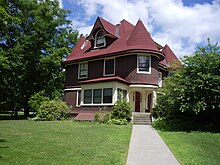
Epsilon Kappa Theta, 2007
Epsilon Kappa Theta (“EKT,” “Theta”) at Dartmouth College was founded in January 1982 as the Epsilon Kappa colony of the Kappa Alpha Theta national sorority. Epsilon Kappa was the 100th colony of the sorority. The sorority initially met in a wide variety of locations, including the basement of the college president’s house. In 1984, the sorority moved into Brewster Hall, a College-owned house that had previously been used as an International House and later as temporary housing for the Alpha Chi Omega sorority. In 1992, the sisters of the Epsilon Kappa chapter of Kappa Alpha Theta found the strict national rules and the primarily Christian religious readings and rituals of the organization to be antithetical to the spirit of feminism and inclusivity that the chapter desired. The national organization was unhappy with the colony’s decision to disobey their rules and their failure to follow the sorority’s rituals. On May 4, 1992, the Dartmouth chapter notified the Kappa Alpha Theta national organization of its unanimous vote to disaffiliate and become a local sorority. The national organization revoked the charter of Epsilon Kappa. The Dartmouth women chose the new name Epsilon Kappa Theta.[81] The current Epsilon Kappa Theta residence is a Victorian house over 100 years old.[82]
Kappa Delta (ΚΔ)[edit]
Kappa Delta (“KD”), a national sorority, colonized the Eta Xi chapter on the Dartmouth campus in 2009. The Dartmouth Panhellenic Council approved the sorority on May 25, 2009. The Council considered the large pledge classes at other sororities on campus in deciding to authorize another sorority.[83] The sorority recruited its first members in the summer of 2009, and Kappa Delta held its first formal rush during the fall 2009 academic term, offering membership bids to 37 women.[84] Kappa Delta’s new 23-bedroom house at 1 Occom Ridge was built over the 2013–2014 school year and was completed in the Fall of 2014. It contains a formal room, gourmet kitchen, a library, and two bedrooms on the first floor, in addition to 21 more single bedrooms located on the second and third floors. K∆ has one of the strongest sisterhoods on Dartmouth College campus, and the sisterhood is involved in numerous philanthropic endeavors, including working with the Girl Scouts of United States of America, Prevent Child Abuse America, The New Hampshire Children’s Trust, and the Confidence Coalition. Each term, ΚΔ also participates in a “You Make Me Smile” campaign where sisters write encouraging messages on balloons and hand them out across campus to raise spirits before finals week. Along with weekly sisterhood meetings and events, like movie and spa nights, sisters attend formal and semi-formal dances, barbecues, and sisterhood retreats.
Kappa Delta Epsilon (ΚΔΕ)[edit]

Kappa Delta Epsilon, 2007
Kappa Delta Epsilon (“KDE”) is a local sorority founded in the fall of 1993 by the Panhellenic Council at Dartmouth. After the dissolution of the Xi Kappa Chi local sorority in the spring of 1993, the Panhellenic Council decided that there was a need for a new sorority to replace it. Fifty women joined the new sorority in the first rush in the fall of 1993.[85] The Kappa Delta Epsilon physical plant was extensively remodeled by the college during the summer of 2003. The newly remodeled building contains a main meetings room, kitchen, two bedrooms and a back porch on the first floor. The second and third floors contain all bedrooms which house about thirteen more resident sisters. The basement consists of the fireplace room, the pub room, and the sisters-only room.[86]
Kappa Kappa Gamma (ΚΚΓ)[edit]
The Epsilon Chi chapter of Kappa Kappa Gamma (“KKG”, “Kappa”) was founded at Dartmouth on December 30, 1978, and was the second sorority at Dartmouth College.[12] The sisters of Kappa Kappa Gamma sponsor events for the campus, go on sister retreats, holdbarbecues, and have formal and semi-formal dances. They have weekly house meetings in order to communicate news and issues about the house, to catch up on the week’s events, and to spend time with their fellow sisters. Philanthropy is an important part of the Epsilon Chi chapter’s activities. The sisters cook dinners on a regular basis for David’s House, an institution that supports and houses families of sick children at a local hospital, in a joint effort with the brothers of Sigma Alpha Epsilon.[87] Kirsten Gillibrand, class of 1988 and the first Dartmouth alumna elected to the United States House of Representatives, was an officer of Kappa Kappa Gamma as an undergraduate.[88]
Sigma Delta (ΣΔ)[edit]
Sigma Delta (“Sigma Delt”) was the first sorority at Dartmouth College, founded in May 1977 as a chapter of the national sorority Sigma Kappa. In April 1981, Sigma Kappa moved into a residence formerly inhabited by the Phi Gamma Delta fraternity. The local chapter at Dartmouth began to have differences with the national organization concerning religion in sorority rituals and an emphasis on men in national sorority songs. The Dartmouth chapter dissociated from the national organization in the fall of 1988, becoming Sigma Delta. The classes of 1989, 1990, and 1991 that formed the new local sorority dedicated the new organization to principles of “strength, friendship, and acceptance of difference”. Since reorganizing as a local sorority, Sigma Delta has hosted at least one open party each term in addition to service events.[89] Actress Connie Britton (89′) was a member of the first local class and served as Sisterhood Chair during her sophomore summer.[90]
Sigma Lambda Upsilon (ΣΛΥ)[edit]
Sigma Lambda Upsilon, more formally known as Sigma Lambda Upsilon/Señoritas Latinas Unidas Sorority, Inc., was established by four women at Dartmouth College in 2003, as the Alpha Beta chapter of the national, historically-Latina sorority. The sorority has no physical plant or designated College-owned housing. The Dartmouth chapter supports several activities including philanthropic events, formal dinners, and a Summer Book Club.
Coeducational fraternities[edit]
The three coeducational fraternities at Dartmouth College are organized and represented to the College through the Coed Council. The Coed Council is a student-led governance organization that assists the member Greek organizations with public relations, programming, recruitment, and academic achievement.[18] All three coeducational fraternities at Dartmouth own the land and residence buildings they occupy.[91][92][93]
Alpha Theta (ΑΘ)[edit]
Alpha Theta was founded as a local fraternity named Iota Sigma Upsilon on March 3, 1920, by a group of seven students. In 1921 the fraternity received a charter as the Alpha Theta chapter of Theta Chi. John Sloan Dickey, later President of the College, joined the fraternity in 1928 and was elected house president only two weeks later, while still a pledge. Nine brothers of Theta Chi died in a tragic accident on the morning of February 25, 1934, when the metal chimney of the building’s old coal furnace blew out in the night and the residence filled with poisonous carbon monoxide gas.[8] Alpha Theta was one of the first collegiate fraternities in the United States to break from its national organization over civil rights issues. In 1951, while Dickey served as President of the College, the student body passed a resolution calling on all fraternities to eliminate racial discrimination from their constitutions. The Theta Chi national organization’s constitution contained a clause limiting membership in fraternity to “Caucasians” only. On April 24, 1952, the members of the Dartmouth chapter voted unanimously to stop recognizing the racial clause in Theta Chi’s constitution.[94] Upon learning that the Dartmouth delegation to Theta Chi’s national convention later that year planned to raise questions about the clause, the Alpha Theta chapter was derecognized by the national organization on July 25, 1952.[95] The house reincorporated as a local fraternity and adopted the name Alpha Theta. Alpha Theta was also one of the first all-male fraternities to admit female members. In 1972, Dartmouth admitted the first class of female students and officially became a coeducational institution. Alpha Theta also voted to become coeducational. After a few years, most of the women in the fraternity had become inactive and the house voted to become single-sex male-only again on November 10, 1976. The house returned to a coeducational membership policy in 1980.[96]
The Tabard (ΣΕΧ)[edit]
The Tabard at Dartmouth College was founded in 1857 as a local fraternity for students in the Chandler Scientific School named Phi Zeta Mu. In 1893, as the Chandler School was absorbed by Dartmouth, the house sought to associate itself with a national fraternity and was granted a charter as the Eta Eta chapter of Sigma Chi national fraternity. In April 1960, the Dartmouth chapter of Sigma Chi became the third fraternity on campus to dissociate from its national organization, following the 1954 Undergraduate Council referendum requiring fraternities to amend its national charters to end discrimination against minorities or go “local”.[97][98] The fraternity officially chose to use the name The Tabard, but retained use of the Greek letters ΣΧ for its local corporation use to include all living and deceased members of both the chapter’s national affiliation and the new local independent organization. The new name was inspired by The Tabard, a fictitious London inn described in the General Prologue of The Canterbury Tales by Geoffrey Chaucer.[99] The Tabard was one of five Greek organizations at Dartmouth to become coeducational and admit women pledges when the College began admitting women students in 1972. The organization unofficially uses the Greek letters Sigma Epsilon Chi (ΣΕΧ), having inserted an “E” between the Sigma and Chi on a wrought iron railing above the front door of their residence. Prominent alumni of the Tabard include: its first president Stephen W. Bosworth, class of 1961 – U.S. Ambassador to South Korea, the Philippines, and Tunisia, as well as Chairman of the Board of Trustees of Dartmouth College; Gordon Campbell, class of 1970 – the 34thPremier of British Columbia; and Aisha Tyler, class of 1992 – an American actress, comedian, and author.[100]
Phi Tau (ΦΤ)[edit]
Phi Tau was founded at Dartmouth College in 1905 as the Tau Chapter of Phi Sigma Kappa. While the national fraternity proved to be an early leader among its peers in the area of non-discrimination, mid-1950s Tau Chapter leaders led the demand for such post-war era changes. The pace of change was contentious: Phi Sigma Kappa had previously had occasional foreign student members at many chapters. Unlike other fraternities, it had also welcomed Catholics and Jews at a time when most fraternity members were Protestant. But it did not yet welcome Blacks. In a reactionary response to a short-lived policy that limited pledging of Black students between 1952–56, and in a move that allowed it to avoid unpaid debts to the national, Tau broke with Phi Sigma Kappa and reformed itself as Phi Tau on March 7, 1956, naming the national fraternity as racist.[11] Yet ironically, the Dartmouth chapter won the debate over the issue: the same discriminatory policy that caused Tau to withdraw was itself rescinded by the national fraternity at its Summer Convention just two months later, leaving Phi Sigma Kappa chapters free to pledge Black members. There has been no reconciliation, even though both groups remain progressive.[101] Today, Phi Tau prides itself on its progressiveness; when the house constitution was rewritten in 1956, references to gender were deliberately excluded, making the house officially coeducational even before Dartmouth College accepted women as students. Phi Tau is the only coeducational Greek organization at Dartmouth that has always had female members since first admitting them, and was the first Greek house at Dartmouth to add sexual orientation to its non-discrimination clause. Members of Phi Tau refer to one another as “brothers” regardless of gender. The fraternity is known for its quarterly “Milque and Cookies” party, featuring thousands of homemade cookies and milkshakes.[102] Phi Tau completely replaced their residence hall in 2002, at a cost of $1.8 million, funded in part by the sale of 1,675 square metres (0.4 acres) of land to the College.[93]
Reemerging Greek organizations[edit]
As of 2008, three derecognized or otherwise inactive Greek organizations are in the process of returning to campus.
Alpha Kappa Alpha (ΑΚΑ)[edit]
Alpha Kappa Alpha (AKA) at Dartmouth College was founded in 1983 as the Xi Lambda chapter of the national sorority. Alpha Kappa Alpha was the first historically African-American sorority at Dartmouth College. The College supported the sorority with dedicated apartment housing until it became defunct in the spring of 2003. The sorority had no members of the class of 2004 and was unable to recruit new members for subsequent classes because of a national moratorium on recruitment related to a hazing incident at another chapter.[103] In February 2008, it was announced that Alpha Kappa Alpha would return to campus and resume activity in the spring or fall of 2008.[104]
Defunct Greek organizations[edit]
Greek organizations at Dartmouth College that dissolved over the years have largely done so as a result of financial difficulties or critically low membership and interest.
The Zayin chapter of Acacia, a national fraternity, was founded at Dartmouth on March 31, 1906. The Acacia national organization never heard from the Dartmouth chapter again, and lacks records of any student members or activities that the chapter might have pursued. The national declared the chapter dissolved in 1908. Acacia was the first fraternity at Dartmouth to dissolve, and the Zayin chapter was the first Acacia chapter at any campus to close.[105]
Alpha Sigma Phi (ΑΣΦ)[edit]
Alpha Sigma Phi at Dartmouth College was originally founded in 1925, as a local fraternity named Sigma Alpha, The local fraternity became the Alpha Eta chapter of Alpha Sigma Phi, a national fraternity, in 1928. Faced with financial difficulties during the Great Depression, the Dartmouth chapter dissolved in 1936.[12] C. Everett Koop, class of 1937 andSurgeon General of the United States from 1982 to 1989, was a member of one of the final Alpha Sigma Phi pledge classes at Dartmouth.[106]
Alpha Tau Omega (ΑΤΩ)[edit]
Alpha Tau Omega was founded at Dartmouth College in 1915 as the local fraternity Sigma Tau Omega. In 1924, the local fraternity was granted a charter to become the Delta Sigma chapter of national fraternity Alpha Tau Omega. The Dartmouth chapter dissolved in 1936, at the height of the Great Depression.[12]
Delta Kappa Epsilon (ΔΚΕ)[edit]
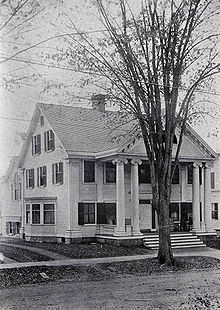
Delta Kappa Epsilon, circa 1915
The Pi Chapter of Delta Kappa Epsilon (“Deke”) was founded in 1853. It was the fourth social fraternity at Dartmouth College. Eight brothers of Delta Kappa Epsilon were famously involved in a 1949 murder of a fellow Dartmouth student. The men, after heavy drinking at three different fraternities, sought out a former member of the freshman football team. Finding him asleep in his dormitory room, but wearing a letter sweater that the eight men felt he did not deserve to be wearing, they beat him and he soon thereafter died of the injuries. Two Delta Kappa Epsilon brothers were brought to trial, fined, and given suspended sentences for the crime. In response to the murder, College President John Sloan Dickey announced that he felt it was important to reduce the influence of the fraternity system on campus.[107] The organization was renamed Storrs House in 1970 before dissolving entirely.[12]
Delta Sigma Theta (ΔΣΘ)[edit]
Delta Sigma Theta is an historically African-American sorority at Dartmouth College that was founded in 1982 as the Che-Ase Interest Group. At the time, the College had imposed a moratorium on the founding on new sororities, but when the moratorium was lifted, the group was recognized by the college as a sorority in the fall of 1984. The women contacted the Delta Sigma Theta national sorority and were granted a charter as the Pi Theta chapter in the spring of 1985.[108] Delta Sigma Theta provided an extensive array of public service through the Five-Point Thrust program.[109] Until the chapter’s dissolution, the sisters of Delta Sigma Theta had cosponsored the Step Show, an annual cultural dance performance, with the brothers of Alpha Phi Alpha. The sorority had occupied dedicated College-owned apartment housing until June, 2004, when all but one member of the Dartmouth chapter graduated. An attempt was made to recruit new members in the summer, and it succeeded, but not for long, as the chapter currently has no members at Dartmouth.[103]
Delta Upsilon (ΔΥ)[edit]
Delta Upsilon at Dartmouth College was originally founded as Epsilon Kappa Phi, a local fraternity, at Dartmouth College in 1920. In 1926, the local fraternity became the Dartmouth chapter of Delta Upsilon, a national fraternity. The fraternity dissociated from the national in 1966, and adopted the name Foley House. Foley House was one of the six local Greek organizations that became coeducational in 1972. In 1984, the organization decided to drop its association with the Greek system entirely and became one of the Affinity Housing programs offered by the College, available to any student interested in cooperative housing.[12]
Delta Phi Epsilon (ΔΦΕ)[edit]
Delta Phi Epsilon was founded at Dartmouth College in 1984 as the Epsilon Alpha chapter of the national sorority. The sorority was derecognized by the College in June, 1989, when it failed to maintain an active membership of at least 35 students.[110] The Dartmouth chapter made an effort to revive itself by separating from the national in 1990 to become Pi Sigma Psi, a local sorority, but dissolved soon thereafter.[12]
Delta Psi Delta (ΔΨΔ)[edit]
Delta Psi Delta was established at Dartmouth College in 1950 as the Dartmouth chapter of Tau Epsilon Phi, a national fraternity. The Dartmouth chapter dissociated from the national in 1969, and reformed itself as the Harold Parmington Foundation. Faced with falling membership in 1981, the fraternity reformed itself with a more traditional Greek letter name, Delta Psi Delta, and opened its membership to women as well as men. Faced with critically low enrollment, Delta Psi Delta finally dissolved in 1991.[12] The local, coeducational fraternity at Dartmouth was not associated with either the Canadian sorority[111] or the local fraternities at California State University, Chico[112] and Linfield College[113] also named Delta Psi Delta.
Zeta Beta Chi (ΖΒΧ)[edit]
Zeta Beta Chi was founded in 1984 as a local sorority named Alpha Beta. In 1986, the sorority gained a charter as the Dartmouth chapter of Delta Gamma, a national sorority. In 1997, the sorority voted to go local again, and reformed as Zeta Beta Chi. Plagued with low membership, the sorority was already on a marginal financial footing in 1998, when a College inspection during the summer discovered mercury contamination in the sorority’s basement, the former house of Arthur Sherburne Hardy. The College closed the building for the remainder of the year, negatively impacting fall rush. The sorority announced its dissolution in December 1998.[107]
Harold Parmington Foundation (HPF)[edit]
The Harold Parmington Foundation was a local fraternity founded in 1970 after the Dartmouth chapter of Tau Epsilon Phi dissociated from its national organization. The new local fraternity continued to reside in 15 Webster Avenue, the house now occupied by the Epsilon Kappa Theta sorority. With only one member each from the classes of 1983 and 1984, the fraternity reorganized itself as a coeducational fraternity named Delta Psi Delta.[114] A past president of the fraternity, Brian Dale, class of 1980, was one of the passengers on American Airlines Flight 11 that was hijacked and flown into the North Tower of the World Trade Center in New York City during the September 11, 2001 attacks.[114][115]
Kappa Alpha Psi (ΚΑΨ)[edit]
Kappa Alpha Psi at Dartmouth College was founded in 1987 as the Mu Chi chapter of the national fraternity. Kappa Alpha Psi was the second historically African-American fraternity at Dartmouth College. Its membership was active through at least the end of the 1990s. The Kappa Alpha Psi national currently lists the Mu Chi chapter as inactive.[116]
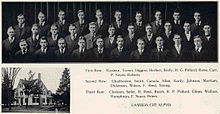
The brotherhood and physical plant of Lambda Chi Alpha in the 1922 Dartmouth College yearbook, The Aegis
Lambda Chi Alpha (ΛΧΑ)[edit]
Lambda Chi Alpha was founded at Dartmouth College in 1914 as the Theta Zeta chapter of the national fraternity. Faced with insurmountable financial stress during the Great Depression, the Dartmouth chapter dissolved in 1932.[12]
Xi Kappa Chi (ΞΚΧ)[edit]
Xi Kappa Chi was originally established at Dartmouth in 1980 as the Zeta Mu chapter of Alpha Chi Omega, a national sorority. The sorority dissociated from the national organization in 1990 and became a local sorority named Xi Kappa Chi. Faced with low membership in 1993, the local sorority considered an affiliation with Phi Mu, a national sorority, as a possibility of attracting more new members hesitant to rush a small local sorority. The Phi Mu national organization sent representatives to Dartmouth in April, 1993, but based on their report, the Phi Mu national council voted against a Dartmouth chapter. Xi Kappa Chi was dissolved by the Dartmouth Panhellenic Council in 1993.[117]
Pi Lambda Phi (ΠΛΦ)[edit]
The Pi chapter of the national fraternity Pi Lambda Phi was established at Dartmouth College in 1924. The membership of the Dartmouth chapter was predominantly Jewish. About half of the College’s fraternities at the time had national constitutions that explicitly forbade membership to Jews, and for many of the other chapters, it was an informal policy to exclude membership to Jewish students. The national constitution of Pi Lambda Phi expressly accepted members of all religions. Pi Lambda Phi was not initially accepted by the Dartmouth Greek community, and efforts in 1924 and 1925 to gain formal admission into the Interfraternity Council failed. The fraternity was finally recognized in the spring of 1927.[118] The fraternity’s first residence, purchased in 1924, was a building on South Street originally occupied by a Roman Catholic church. The fraternity would reside there until 1961, when it moved to a house north of Webster Avenue on Occom Ridge. The chapter dissolved in 1971.[3]
Sigma Alpha Mu (ΣΑΜ)[edit]
Sigma Alpha Mu was established at Dartmouth College in 1930 as the Sigma Upsilon chapter of the national fraternity. At the time, the Sigma Alpha Mu national limited membership in the organization to Jewish men. Sigma Alpha Mu placed more emphasis on the observances of Judaism than did the other predominantly Jewish fraternity on campus, Pi Lambda Phi, and had difficulty attracting the interest of most mainstream Jewish students on campus.[118] The Dartmouth chapter dissolved in 1935, during the Great Depression.[12]
Tau Epsilon Phi (ΤΕΦ)[edit]
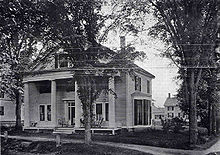
Phi Gamma Delta, circa 1915
Tau Epsilon Phi was established at Dartmouth College in 1950 as the Epsilon Delta chapter of the national fraternity. The Dartmouth chapter dissociated from the national in 1969, and voted to call itself the Harold Parmington Foundation.[12]
Phi Gamma Delta (FIJI)[edit]
Phi Gamma Delta was founded at Dartmouth College as the Delta Upsilon chapter of the national fraternity in 1901. The Dartmouth chapter seceded from the national fraternity in 1965, and adopted the new name of Phoenix. The new local fraternity dissolved in 1971.[12]The fraternity has no association with the Phoenix all-female senior society founded at Dartmouth in 1984.
Phi Kappa Psi (ΦKΨ)[edit]

Phi Kappa Psi, circa 1915
Phi Kappa Psi (“Phi Psi”) traces its heritage at Dartmouth College to the Beta Psi local fraternity, founded in 1895. Beta Psi became the New Hampshire Alpha chapter of Phi Kappa Psi in 1896. The Dartmouth chapter dissociated from the national in 1967 as a result of the national’s reaction to the chapter’s pledging of a black pledge, adopting the new name Phi Sigma Psi. Phi Sigma Psi was one of the six fraternities that adopted a formal coeducational membership policy in 1972. In the late 1980s, the membership began referring to the organization as “Phi Psi/Panarchy”. The fraternity changed its name to The Panarchy in 1991.[119] In 1993, the College began a program for “undergraduate societies” as open-membership alternatives to the Greek system. In September 1993, the members of Panarchy voted to disaffiliate from the Greek system and became the first of two Undergraduate Societies.[120]



